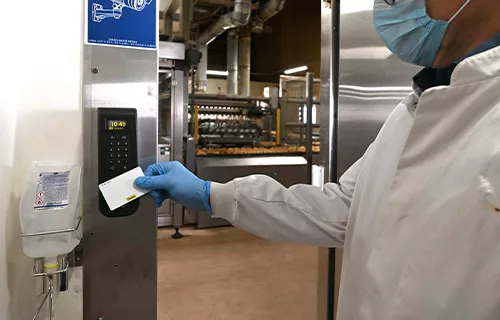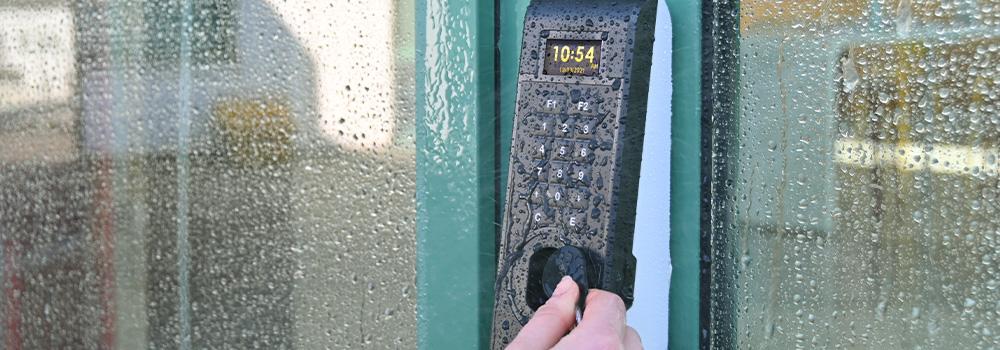Your clocking in system is an essential tool that supports you and your employees on a daily basis. But is it suitable for your working conditions? From dust to cleaning and temperature variations, your work environment can have a major impact on the efficiency and lifespan of the system you choose. How do you choose the most suitable clocking terminal for your working conditions and where do you install it? What are the technical features you should pay attention to?
Clocking In Terminals and The Work Environment: What is Suitable?
Your working environment can be very restrictive in terms of the installation of a terminal and use of electronic equipment. There are several factors to consider: Exposure to extreme temperatures, dust, water, and cleaning products which can reduce the efficiency and longevity of a terminal; a less robust system can cause malfunctions and breakages, preventing future clocking ins and disrupting the work flow of the HR team. These lead to wasted time, stress for users, and additional workload for human resources.
Clocking in systems are not limited to offices and are often found in harsh environments. It is important to evaluate which elements they will be exposed to and the level of impact they will have.
Workshop Clocking In: Beware of Fine Dust!
Clocking in terminals can be installed in dusty environments, such as, metallurgical workshops and carpentry / cabinet making. In this type of environment, various materials produce very fine particles when they are cut. Exposing your terminals to this type of setting can affect how they operate, therefore, your equipment must be able to withstand fine dust and other unwanted residues.
It is important to be aware of the IP rating; the industry-recognised system for determining degrees of protection needed against solids, such as dirt and dust, and moisture, such as drips and sprays.
There is a separate IP rating for solids and liquids. The first scale, for solid penetration ranges from 0 to 6: from no protection to complete protection. In an office environment, where there is an element of protection against debris, a rating of 2 is usually sufficient. Opting for a clocking terminal with an index of 0 will allow many particles to pass through and will eventually affect its operation.
Water Resistance: Do You Need a Waterproof Terminal?
When an environment is exposed to water, it is helpful to consider the second scale of the IP rating, specifically designed for the ‘entrance of water’. This includes humid environments, such as in the food industry or hospitals, or in industrial settings where the terminal will be cleaned thoroughly and regularly. This second scale ranges from 0 to 8: from no protection to protection against long periods of water immersion under pressure. This may not be relevant for an office but for an industrial setting, it is necessary to protect against water using the rating of 4 or 5.
Generally, a rating of 5 is sufficient for use in indoor humid environments or for indoor installations exposed to rain.
Clocking in Terminals and Temperature Variations
Some work environments are exposed to extreme temperatures. Whether the exposure is very high or very low, your terminal must be adapted to this type of situation and able to withstand the temperatures it is subjected to, such as the more extreme temperatures in a greenhouse or in a cold storage facility.
All electronic equipment is designed to withstand a certain temperature range. The electronic components and battery must be chosen according to the temperature range in which the equipment will be installed. If the temperature range is not suitable, it can permanently damage your terminal: internal components may no longer work; the battery may expand or even explode if exposed to too high temperatures; and the screen can freeze if the temperatures are too low. Therefore, your clocking in system must offer a wide temperature range that extends from negative temperatures to the highest temperatures that you may need.

Robust Clocking Terminal: Being Exposed to Impact
When the clocking terminal is installed, for example in a warehouse, machines and pallet trucks are regularly transported throughout the premises. In this situation, it is essential to ensure that your equipment is robust enough to withstand even the slightest impact or shock and that its functionality will not be altered.
The international IK rating is a helpful measure of the strength of the impact that a product can tolerate. It has a scale from 0 to 10 depending on the distance from the impact, the force applied to it and the weight of the object causing the damage.
For example, the IK rating ranges from 0: no impact, to 10: 40cm from the object at an impact of 20 joules. IK07 or IK08 indicate a good cost / strength compromise.
If your clocking in terminal is in an environment exposed to possible accidental knocks and damage, it is necessary to check which rating is applicable. Choosing a rating that is too high in relation to the exposure will not be useful and will cost more to buy.
Clocking In in the Sun or Dark: Opt for Flawless Visibility
When the clocking terminal is exposed to the outdoors or in a dark environment, care must be taken to ensure that the screen is always legible. To guarantee this, you need to look at the type of screen that the clock has.
The best option is the OLED screen (Organic Light-Emitting Diode) that doesn't require a backlight system. It is composed of pixels, each of which is a light source, which allows it to have a very high contrast ratio and is therefore visible in both bright light and shadow. Due to the wide-angle visibility, OLED screens means that you don’t need to be standing directly in front of the screen to read it.
The Characteristics of a Clocking Terminal in Extreme Environments: Make the Right Choice!
Paying attention to the features mentioned will allow you to choose a clocking in system suitable for extreme working conditions, but these are not the only features to pay attention to. Practicality of use is also important on a daily basis: how easy is it to clock in? How do I want to clock in? Can some staff clock in remotely if needed? These are all points that you need to pay as much attention to in order to find the right terminal that will suit your environment and its users.
Kelio’s Xtrem offers a robust clocking terminal designed for extreme environments, including resistance to rain, dust, heat and cold. With an IP rating of IP65 and IK08 rating for shock resistance, you are protected in most common industrial environments. It can be high pressure cleaned and is adapted for outdoor use and in very bright environments.
Durable, shockproof, resistant to heat (up to 50C) and cold (to -15C) humidity and dust, and also functions as an Access Control reader… call our sales team for a quote of and find out how Kelio can support you.



